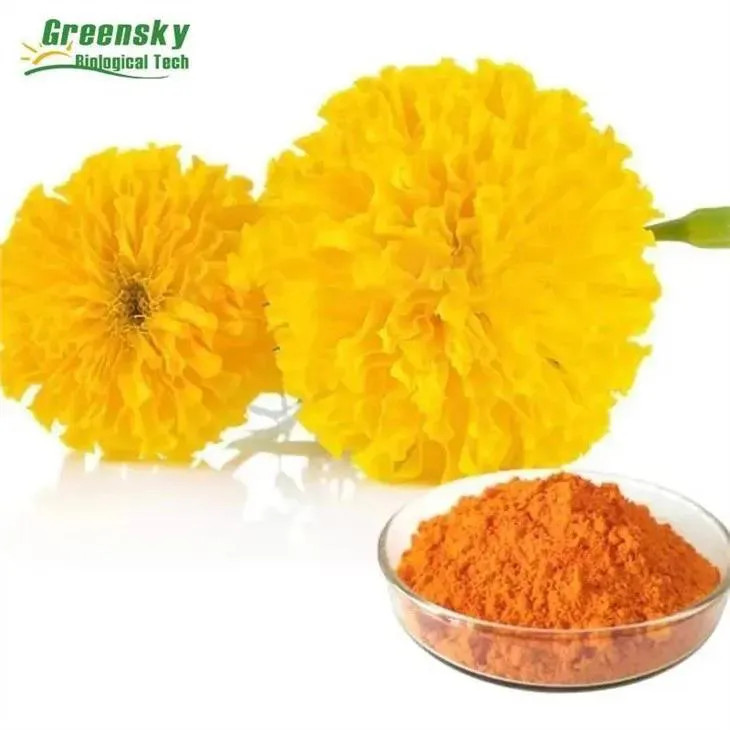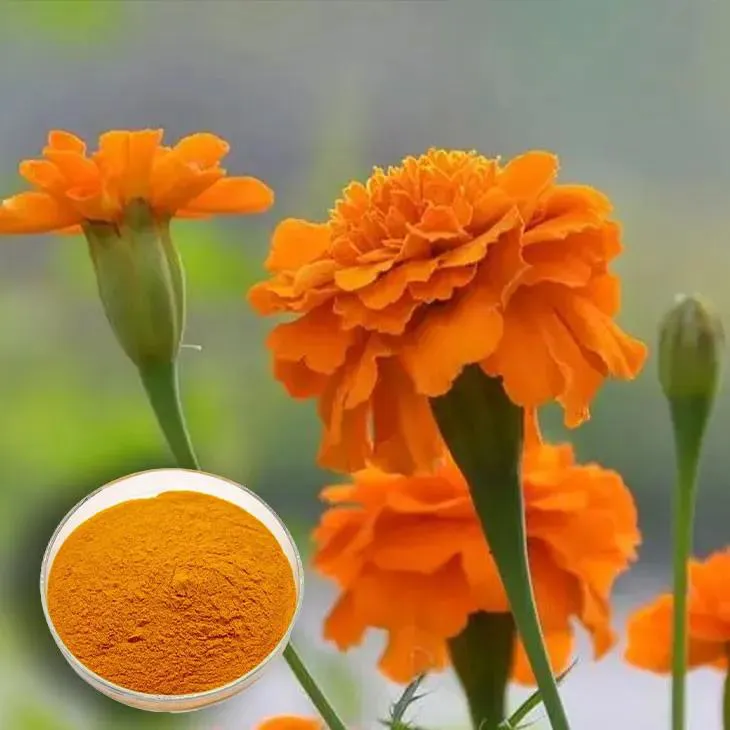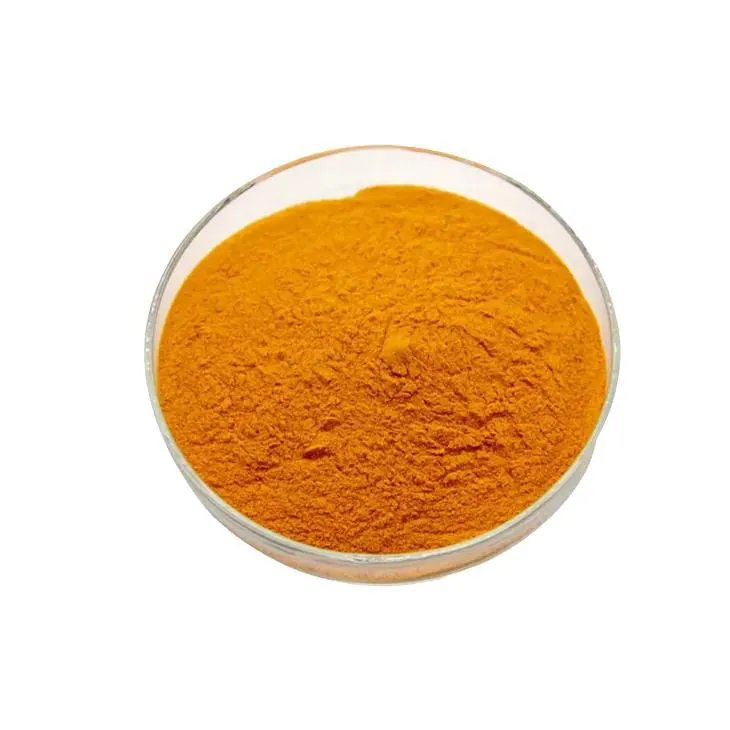- 0086-571-85302990
- sales@greenskybio.com
How to Extract Marigold Extract by Steam Distillation.
2024-11-30

1. Introduction to Marigold Extract and Steam Distillation
Marigold Extract is highly valued in various industries, such as cosmetics, food, and pharmaceuticals. It contains numerous beneficial compounds, including flavonoids, carotenoids, and essential oils. Steam distillation is a widely used method for extracting volatile compounds from plants, and it is also very effective for obtaining Marigold Extract.
Steam distillation is based on the principle that when steam is passed through the plant material, the volatile compounds in the marigold are vaporized. These vapors are then condensed back into a liquid, which contains the desired extract. This method has several advantages, including the ability to extract compounds at relatively low temperatures, which helps preserve their integrity.

2. Equipment Needed for Steam Distillation of Marigold
- Steam generator: This can be a simple kettle or a more specialized steam - producing device. It should be able to produce a consistent supply of steam.
- Distillation flask: A flask large enough to hold the marigold material. It should be made of heat - resistant glass, such as borosilicate glass.
- Condenser: Usually a water - cooled condenser. The condenser cools the vapors back into a liquid state.
- Receiver flask: To collect the distilled marigold extract.
- Thermometer: To monitor the temperature during the distillation process.
- Stirring device (optional): If using a large amount of marigold material, a stirring device can help ensure even heating and extraction.

3. Preparation of Marigold Material
- Harvesting: Select fresh and healthy marigold flowers. The best time to harvest is usually when the flowers are fully open. Avoid using flowers that are wilted or damaged.
- Cleaning: Gently wash the marigold flowers to remove any dirt, debris, or insects. Use a soft brush if necessary to clean the petals without causing damage.
- Drying (optional): In some cases, it may be beneficial to dry the marigold flowers slightly before distillation. This can be done in a well - ventilated area at a low temperature. However, for some applications, fresh flowers may be preferred.
- Chopping or Grinding: Cut the marigold flowers into smaller pieces or grind them gently. This increases the surface area available for steam to interact with the plant material, facilitating better extraction.

4. The Steam Distillation Process
- Setup: Assemble the steam distillation apparatus. Connect the steam generator to the distillation flask, and attach the condenser to the distillation flask. Place the receiver flask at the end of the condenser to collect the extract.
- Loading the Marigold: Place the prepared marigold material into the distillation flask. Make sure not to overfill the flask, leaving some space for the steam to circulate.
- Starting the Steam: Turn on the steam generator. Adjust the steam flow so that it is a steady stream. The steam should start to pass through the marigold material in the distillation flask.
- Monitoring the Temperature: Use the thermometer to monitor the temperature inside the distillation flask. The temperature should be maintained within a certain range depending on the nature of the marigold compounds being extracted. Generally, a temperature range of 100 - 150°C may be appropriate.
- Condensation: As the steam passes through the marigold and vaporizes the volatile compounds, these vapors move into the condenser. The condenser, cooled by running water, cools the vapors back into a liquid state. The condensed liquid, which contains the marigold extract, drips into the receiver flask.
- Duration of Distillation: The distillation process may take several hours, depending on the amount of marigold material and the efficiency of the apparatus. Continuously monitor the process and the amount of extract being collected in the receiver flask.
- Ending the Process: When the desired amount of extract has been collected or when the steam no longer seems to be carrying significant amounts of volatile compounds (as indicated by a decrease in the rate of condensation), turn off the steam generator and allow the apparatus to cool down.

5. Post - Distillation Processing
- Separation: Once the distillation is complete, the collected liquid in the receiver flask may contain not only the marigold extract but also some water. If necessary, use techniques such as separation funnels or centrifugation to separate the extract from the water phase.
- Filtration: Filter the marigold extract through a fine filter, such as a filter paper or a membrane filter. This helps remove any remaining solid particles or impurities.
- Storage: Store the marigold extract in a dark, cool, and dry place. Use amber - colored glass bottles to protect the extract from light, as light can degrade some of the compounds in the extract.
6. Quality Control and Analysis
- Spectroscopic Analysis: Use techniques such as ultraviolet - visible (UV - Vis) spectroscopy or infrared (IR) spectroscopy to analyze the chemical composition of the marigold extract. These techniques can help identify the presence of key compounds like carotenoids and flavonoids.
- Chromatographic Analysis: High - performance liquid chromatography (HPLC) or gas chromatography (GC) can be used to separate and quantify the individual components in the marigold extract. This is important for ensuring the consistency and quality of the extract.
- Purity Checks: Check for the presence of contaminants, such as heavy metals or pesticides. This can be done through techniques like atomic absorption spectroscopy for heavy metals and enzyme - linked immunosorbent assays (ELISA) for pesticides.
7. Tips for High - Quality Marigold Extract by Steam Distillation
- Proper Material Handling: Always handle the marigold material gently to avoid bruising or damaging the plant tissue. This helps preserve the integrity of the compounds within the marigold.
- Maintain Steady Steam Flow: A consistent steam flow is crucial for efficient extraction. Fluctuations in steam flow can lead to incomplete extraction or the degradation of some compounds.
- Clean Equipment: Ensure that all the distillation equipment is thoroughly cleaned before use. Residues from previous extractions can contaminate the marigold extract.
- Optimal Temperature Control: Carefully control the temperature during the distillation process. Too high a temperature can cause the degradation of some volatile compounds, while too low a temperature may result in incomplete extraction.
- Fresh Material: Whenever possible, use fresh marigold flowers for extraction. Fresh material generally contains higher levels of volatile compounds compared to stored or dried material.
8. Conclusion
Steam distillation is a reliable and effective method for extracting marigold extract. By following the proper procedures, from preparing the marigold material to post - distillation processing and quality control, it is possible to obtain high - quality marigold extract. This extract can then be used in a wide range of applications, contributing to the development of various products in the cosmetics, food, and pharmaceutical industries.
FAQ:
Q1: What is the principle behind steam distillation for marigold extract?
Steam distillation works on the principle that when steam is passed through the marigold plant material, the volatile compounds in the marigold get vaporized along with the steam. Since the boiling point of the mixture of steam and volatile compounds is lower than that of the individual components, they can be evaporated at a relatively lower temperature. These vaporized components are then condensed back to liquid form, separating the marigold extract from the non - volatile parts of the plant.
Q2: What are the ideal conditions for steam distilling marigold extract?
The ideal conditions include maintaining a proper temperature. Usually, a temperature range that allows the efficient vaporization of the volatile components without causing degradation of the active compounds is preferred. A consistent supply of steam at an appropriate pressure is also crucial. Additionally, the ratio of marigold plant material to water (used to generate steam) should be carefully adjusted. For example, a ratio of about 1:5 (marigold to water) can be a starting point, but this may vary depending on the equipment and the specific marigold variety.
Q3: How long does the steam distillation process for marigold extract usually take?
The duration of the steam distillation process can vary significantly depending on factors such as the amount of marigold material, the efficiency of the distillation equipment, and the desired concentration of the extract. Generally, it can take anywhere from 2 - 6 hours. However, in some cases where a more concentrated or pure extract is required, it may take longer, up to 8 - 10 hours.
Q4: What precautions should be taken during steam distillation of marigold extract?
Firstly, ensure that the equipment is clean and properly assembled to prevent contamination. The temperature and pressure should be carefully monitored to avoid overheating or pressure build - up which could damage the equipment or degrade the extract. Also, make sure that the marigold material is properly prepared, for example, it should be dried to an appropriate level (not too wet or too dry) before being placed in the distillation apparatus. Additionally, use proper safety equipment such as heat - resistant gloves and goggles as steam can cause burns.
Q5: How can the quality of the marigold extract obtained by steam distillation be determined?
The quality of the marigold extract can be determined through several methods. One way is to analyze its chemical composition using techniques like gas chromatography - mass spectrometry (GC - MS) to identify and quantify the key volatile compounds present. The color, odor, and clarity of the extract can also provide some indication of its quality. A high - quality marigold extract should have a characteristic golden - yellow color, a pleasant floral odor, and be relatively clear without excessive turbidity.
Related literature
- Steam Distillation in Botanical Extract Production: A Comprehensive Review"
- "Optimization of Steam Distillation for Extracting Bioactive Compounds from Marigold"
- "Marigold Extract: From Steam Distillation to Therapeutic Applications"
- ▶ Hesperidin
- ▶ citrus bioflavonoids
- ▶ plant extract
- ▶ lycopene
- ▶ Diosmin
- ▶ Grape seed extract
- ▶ Sea buckthorn Juice Powder
- ▶ Beetroot powder
- ▶ Hops Extract
- ▶ Artichoke Extract
- ▶ Reishi mushroom extract
- ▶ Astaxanthin
- ▶ Green Tea Extract
- ▶ Curcumin Extract
- ▶ Horse Chestnut Extract
- ▶ Other Problems
- ▶ Boswellia Serrata Extract
- ▶ Resveratrol Extract
- ▶ Marigold Extract
- ▶ Grape Leaf Extract
- ▶ blog3
- ▶ blog4
-
Chinese Motherwort Extract Powder Factory.
2024-11-30
-
100% 纯有机葡萄籽提取物粉
2024-11-30
-
Manufacturers of Organic Diosmin Powder.
2024-11-30
-
Chinese Eucommia ulmoides Extract Suppliers.
2024-11-30
-
Passionflower Extract
2024-11-30
-
Stevia Extract
2024-11-30
-
Ginseng Root Extract
2024-11-30
-
Natural grape seed extract
2024-11-30
-
Citrus bioflavonoids
2024-11-30
-
Panax Ginseng Leaf Extract
2024-11-30
-
Sophora Flavescens Root Extract
2024-11-30
-
Red Vine Extract
2024-11-30
-
American Ginseng Root Extract
2024-11-30
-
Garcinia Cambogia Extract
2024-11-30





















